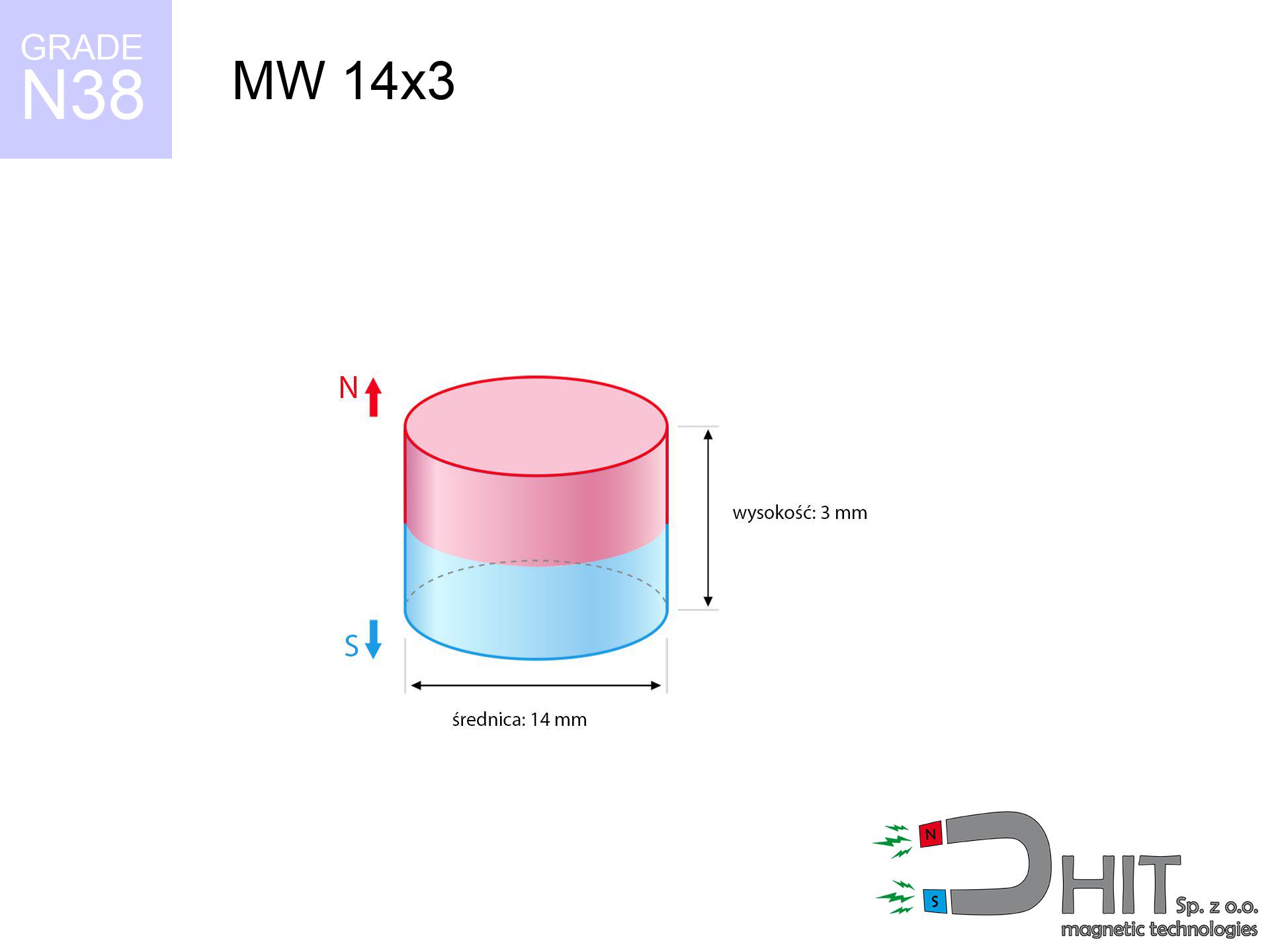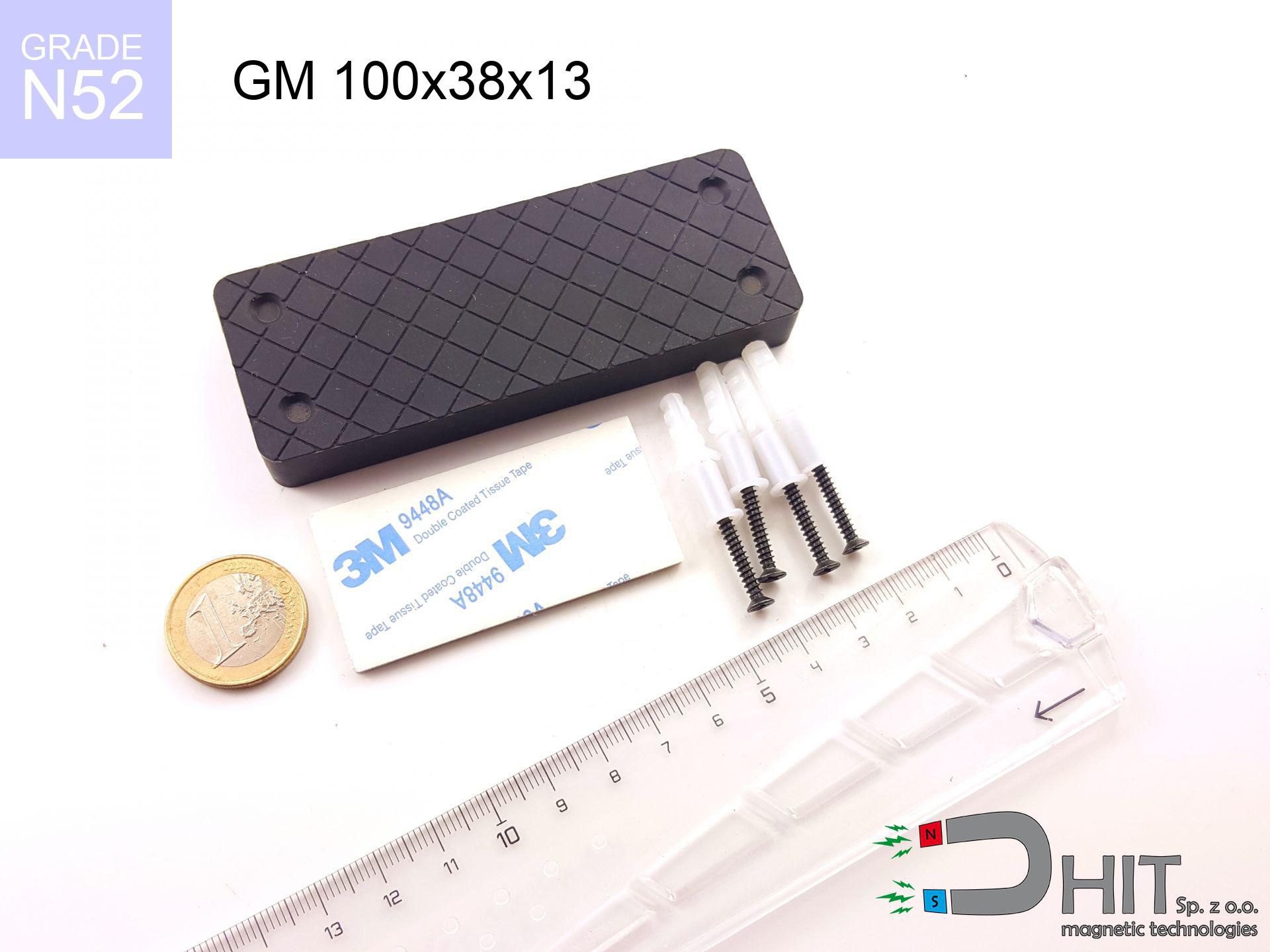MW 14x3 / N38 - cylindrical magnet
cylindrical magnet
Catalog no 010025
GTIN: 5906301810247
Diameter Ø
14 mm [±0,1 mm]
Height
3 mm [±0,1 mm]
Weight
3.46 g
Magnetization Direction
↑ axial
Load capacity
2.32 kg / 22.75 N
Magnetic Induction
244.11 mT
Coating
[NiCuNi] nickel
1.845 ZŁ with VAT / pcs + price for transport
1.500 ZŁ net + 23% VAT / pcs
bulk discounts:
Need more?Hunting for a discount?
Pick up the phone and ask
+48 888 99 98 98
or let us know through
our online form
the contact section.
Force and shape of a neodymium magnet can be calculated with our
modular calculator.
Orders submitted before 14:00 will be dispatched today!
Magnetic properties of material N38
Physical properties of sintered neodymium magnets Nd2Fe14B at 20°C
Shopping tips
Advantages as well as disadvantages of NdFeB magnets.
Besides their remarkable field intensity, neodymium magnets offer the following advantages:
- They retain attractive force for around 10 years – the drop is just ~1% (based on simulations),
- They have excellent resistance to magnetic field loss when exposed to opposing magnetic fields,
- A magnet with a metallic nickel surface has an effective appearance,
- Magnetic induction on the working part of the magnet turns out to be very high,
- Made from properly selected components, these magnets show impressive resistance to high heat, enabling them to function (depending on their form) at temperatures up to 230°C and above...
- Thanks to freedom in constructing and the ability to customize to specific needs,
- Versatile presence in innovative solutions – they are commonly used in magnetic memories, drive modules, medical equipment, also modern systems.
- Compactness – despite small sizes they offer powerful magnetic field, making them ideal for precision applications
Drawbacks and weaknesses of neodymium magnets: tips and applications.
- Brittleness is one of their disadvantages. Upon intense impact they can fracture. We advise keeping them in a steel housing, which not only secures them against impacts but also raises their durability
- Neodymium magnets demagnetize when exposed to high temperatures. After reaching 80°C, many of them experience permanent drop of strength (a factor is the shape as well as dimensions of the magnet). We offer magnets specially adapted to work at temperatures up to 230°C marked [AH], which are very resistant to heat
- They oxidize in a humid environment. For use outdoors we recommend using waterproof magnets e.g. in rubber, plastic
- Due to limitations in producing nuts and complicated shapes in magnets, we propose using casing - magnetic mechanism.
- Health risk related to microscopic parts of magnets pose a threat, in case of ingestion, which gains importance in the context of child health protection. It is also worth noting that small elements of these devices can be problematic in diagnostics medical after entering the body.
- Higher cost of purchase is a significant factor to consider compared to ceramic magnets, especially in budget applications
Maximum holding power of the magnet – what affects it?
The declared magnet strength refers to the limit force, obtained under ideal test conditions, specifically:
- using a plate made of mild steel, serving as a magnetic yoke
- whose transverse dimension equals approx. 10 mm
- characterized by even structure
- with direct contact (without impurities)
- for force acting at a right angle (in the magnet axis)
- at standard ambient temperature
Practical aspects of lifting capacity – factors
Please note that the working load may be lower influenced by elements below, in order of importance:
- Distance – the presence of foreign body (rust, tape, air) acts as an insulator, which lowers power steeply (even by 50% at 0.5 mm).
- Angle of force application – highest force is reached only during pulling at a 90° angle. The resistance to sliding of the magnet along the plate is usually many times lower (approx. 1/5 of the lifting capacity).
- Base massiveness – insufficiently thick sheet causes magnetic saturation, causing part of the power to be escaped into the air.
- Chemical composition of the base – low-carbon steel gives the best results. Higher carbon content decrease magnetic permeability and holding force.
- Surface finish – full contact is obtained only on smooth steel. Any scratches and bumps create air cushions, reducing force.
- Temperature influence – hot environment weakens magnetic field. Exceeding the limit temperature can permanently damage the magnet.
* Lifting capacity testing was conducted on a smooth plate of suitable thickness, under perpendicular forces, in contrast under attempts to slide the magnet the holding force is lower. In addition, even a small distance {between} the magnet and the plate reduces the lifting capacity.
Warnings
Mechanical processing
Mechanical processing of NdFeB material poses a fire risk. Neodymium dust oxidizes rapidly with oxygen and is difficult to extinguish.
Health Danger
For implant holders: Powerful magnets disrupt medical devices. Keep at least 30 cm distance or ask another person to work with the magnets.
Compass and GPS
Note: neodymium magnets generate a field that confuses precision electronics. Maintain a safe distance from your mobile, device, and navigation systems.
Pinching danger
Risk of injury: The pulling power is so great that it can result in blood blisters, pinching, and broken bones. Protective gloves are recommended.
Power loss in heat
Regular neodymium magnets (N-type) undergo demagnetization when the temperature surpasses 80°C. Damage is permanent.
Keep away from children
Adult use only. Small elements pose a choking risk, causing serious injuries. Keep away from kids and pets.
Magnet fragility
Neodymium magnets are sintered ceramics, meaning they are prone to chipping. Clashing of two magnets leads to them shattering into shards.
Safe distance
Avoid bringing magnets near a wallet, laptop, or screen. The magnetic field can permanently damage these devices and erase data from cards.
Do not underestimate power
Handle magnets consciously. Their immense force can shock even professionals. Stay alert and respect their force.
Nickel allergy
It is widely known that nickel (standard magnet coating) is a potent allergen. If your skin reacts to metals, avoid touching magnets with bare hands or choose coated magnets.
Safety First!
Want to know more? Read our article: Are neodymium magnets dangerous?




![UMP 97x40 [M8+M10] GW F300 Lina / N38 - search holder UMP 97x40 [M8+M10] GW F300 Lina / N38 - search holder](https://cdn3.dhit.pl/graphics/products/ump-97x40-m8+m10-gw-f300-+lina-ful.jpg)

![SM 25x325 [2xM8] / N42 - magnetic separator SM 25x325 [2xM8] / N42 - magnetic separator](https://cdn3.dhit.pl/graphics/products/sm-25x325-2xm8-man.jpg)
![SM 18x275 [2xM5] / N42 - magnetic separator SM 18x275 [2xM5] / N42 - magnetic separator](https://cdn3.dhit.pl/graphics/products/sm-18x275-2xm5-zep.jpg)

